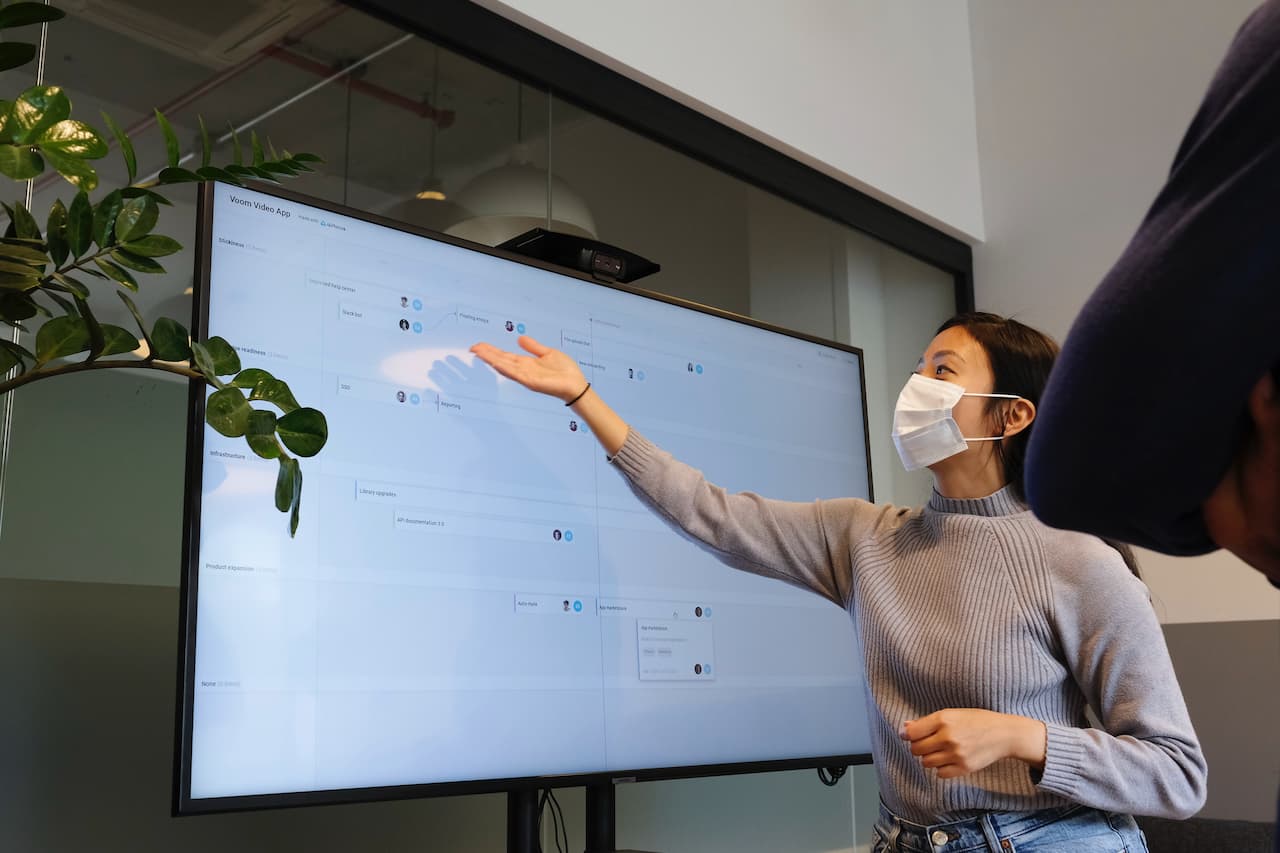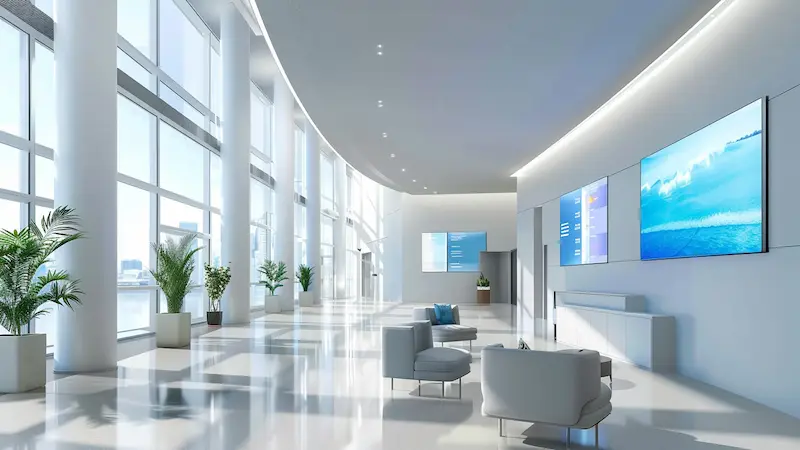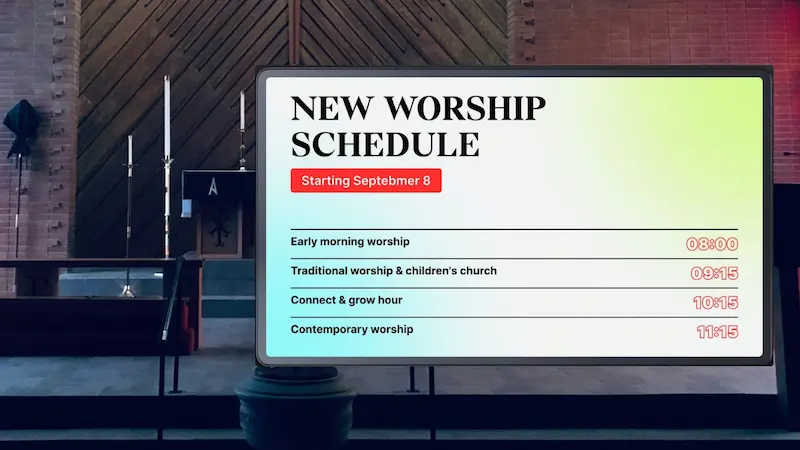
Table of Content
When was the last time your digital displays helped you hit a business objective?
It's a fair question because to most employees, workplace screens are background noise they walk past without really seeing. But there's a growing recognition that digital signage can be much more than that.
Because information drives everything in business today, how quickly your team gets updates, how clearly they understand priorities, and how easily they can access what they need, all of this directly impacts your bottom line.
An enterprise signage system can integrate with your existing business systems, update automatically with real-time data, and show targeted content to specific audiences.
The question is, what separates basic digital displays from real business tools? Explore Look Digital Signage Enterprise features for a comprehensive view.
1. Single Sign‑On (SSO) & SAML Integration for Secure Access
As your signage network grows, more people will need access. Without a unified login, you end up managing separate accounts and passwords for each user.
Single Sign-On (SSO) enables employees to use the same credentials they already use for internal tools to log in to the digital signage system. Look Digital Signage supports SAML-based SSO, so you can connect it to your existing identity provider, such as Azure AD, Google Workspace, or Okta.
When someone joins the company, you can assign signage permissions through your central directory. When they leave, disabling their main account removes access instantly. There is no need to create, reset, or delete separate passwords for each application.
It also reduces IT support overhead. Password reset requests make up 20–50% of all IT help desk tickets, according to Gartner. With SSO, that burden disappears.
2. Granular User Access & Workspace Hierarchies
In large organizations, not everyone needs the same access to your signage system. If every user can control every screen or publish content freely, it becomes hard to manage and easy to make mistakes.
Look Digital Signage gives you a way to assign clear roles and permissions. For instance, a content creator can upload media and build playlists but won’t be able to publish them. A regional manager can update screens in their area without affecting national campaigns. Finance teams can access billing, but not touch screen content.
You can also organize users into separate workspaces based on department, region, store location, or brand. This keeps everyone focused on what’s relevant to them and makes the whole system easier to monitor.
Without this kind of structure, teams either get in each other’s way or rely too much on others to make updates. Neither works well when you’re managing dozens or hundreds of screens.

3. Multi-Site Management
A good enterprise signage system should give you one central place to monitor and manage your screens across multiple locations. Look cloud-based software makes this easy with a single dashboard where you can check which devices are online, what content they’re playing, and whether any screens need attention. If a player stalls, you can reboot it remotely. If headquarters updates an announcement, it can go live across every branch in seconds.
A good example is how Xtreme Express, a logistics company with locations in Columbus, Cleveland, and Cincinnati, can now update content across all three locations in minutes without sending anyone on-site. Safety and HR updates go live instantly on workplace screens and employees stay informed just by glancing up while grabbing their tablets at the start of the day.
“I can get a new screen up in 10 to 15 minutes,” said Andrew Cost, their Safety and Compliance Director. “It was the simplest system we found.”
Multi-site management is especially useful for retail, banking, or healthcare environments where consistency matters but every location runs independently. Instead of relying on local staff to keep things updated, central teams stay in control without micromanaging.
4. Flexible Content Management & Multi‑Zone Layouts
Layered information holds attention better than a static slide.
A flexible content system should let you split your screen into areas and assign different content to each.
In Look Digital Signage, all of this is done in the Layout Designer. You can create multi-zone layouts where different sections of the screen show different content at the same time. For example, you could have a weather ticker running along the top, a promo banner at the bottom, and a welcome video in the middle.
To make this easier, Look gives you access to hundreds of pre-designed templates. You can also use built-in widgets and apps like clocks, countdowns, news feeds, or social media tickers to layer content in a way that keeps the screen both useful and engaging.
Once your layout is ready, you assign it to a playlist and use smart scheduling to automate content updates. You can set content to play during specific hours, on certain days, or over a fixed campaign period. That way, your screens stay current without constant manual updates.
5. Dynamic Integrations & App Support
There are times when updating content manually just doesn’t make sense. Think of stock levels, pricing, event schedules, or live metrics. These things change often, and your screens should reflect those changes automatically.
That’s why your signage system needs to support integrations. It should connect to the tools and data sources your business already uses, and update displays automatically as those systems change.
In Look Digital Signage, these integrations are supported with widgets and built-in apps. You get:
- Power BI dashboards to display live business metrics directly on screen.
- Social media feeds with built-in apps for Instagram, Facebook, and Twitter (X). Use branded hashtags on your social walls to boost real-time engagement.
- RSS feeds and news widgets to stream headlines, local news, or custom content automatically.
- Engagement tools like countdown timers, clocks, and weather widgets to add dynamic, useful content without extra effort.
If you have specific needs like pulling in inventory data, POS updates, or internal dashboards, the open API lets your developers connect directly to your systems. For most cases, though, Look DS integrates with Zapier, so you can automate those connections without writing a single line of code.

6. Strong Security & Audit Trails
Screens might seem low-risk, but they’re connected to your network, user accounts, and live business systems. If someone gains access, they may not just tamper with what's on the screen but might also get a path into internal tools or sensitive data.
IBM’s 2025 Cost of Data Breach report found that the average cost of a data breach is $4.4 million, with over half of breaches traced back to third-party systems. Digital signage shouldn't be the weak link.
If you’re in a data-sensitive industry like healthcare or finance, you need full control over where your data lives and who can access it. Look provides an on-premise option where the entire system runs on your own infrastructure, behind your firewall, managed by your internal team.
If cloud is acceptable, you still get the same level of confidence. Look Digital Signage users benefit from one of the most secure cloud environments available, with data hosted on AWS, encrypted at every stage, and protected by enterprise-grade access controls.
In addition to this, the Look software logs every action. If content is updated, a user is added, or a setting is changed, the system records who did it and when. These logs help you track changes, spot issues quickly, and provide documentation for internal reviews or regulatory compliance.
7. Hardware Flexibility & Scalability
One of the first things teams want to know is, “What kind of screens can we use?” The answer depends on how and where you plan to use them.
Use this as a quick decision guide:
- Outdoor screens - Look for IP-rated, weather-resistant displays built for high brightness and long runtimes.
- Indoor screens with light use - Consumer-grade TVs may be fine for lower-traffic areas or part-time playback.
- 24/7 use - Go with commercial-grade displays that are designed to stay on around the clock without overheating.
- Interactive setups - Tablets and touch-enabled kiosks are fully supported too.
- Already have displays - You can attach an Android box, Fire TV Stick, or professional player instead of replacing hardware.
Read also: Digital Signage Hardware Selection - Ultimate Buyer's Guide
What matters most is that your signage platform doesn’t force you to choose one setup for every location. With Look, you can mix and match display types from different manufacturers based on what makes sense.
If you have have a system-on-chip display, Look DS supports operating systems from major display brands, so you just need to install the app and it runs. If you're using standard displays or need more processing power, you can connect a professional-grade media player and that works too.
See the full list of expert-recommended displays to help plan your rollout.
And the best part is that the number of screens the Look platform can support is limitless so your expansions won't require a complete overhaul.
8. Enterprise SLAs, Support, and Onboarding
When something goes wrong, you need a partner who responds quickly and helps you fix the problem. This is where service-level agreements (SLAs) and support offerings become important.
An SLA is a formal contract between you and the provider that specifies:
- Response time: How quickly will they acknowledge your support request?
- Resolution time: How long will it take to resolve an issue? Vendors may offer different tiers of service with faster or slower commitments depending on the price.
- Support channels: Can you reach them by phone, email, chat? Are there different channels for different severities?
- Availability: Does the vendor offer support 24/7, or only during certain hours? This matters if your signage is customer-facing outside of normal business hours.
Look DS offers 24/7 chat support directly through the dashboard, so help is always within reach when you need it. Businesses also benefit from hands-on guidance on deployment planning, hardware selection, and rollout strategy.
Contact the Look team for personalized guidance.
Beyond the SLA, consider the quality of onboarding and training. There should be a knowledge-base with actionable steps, video tutorials, and live demo sessions to ensure your team knows how to use the system from day one.
Bringing It All Together
If there’s one thing to take from this guide, it’s that a good signage system is one your team won’t outgrow in six months. If the basics like access control, remote updates, hardware support, or security feel shaky now, they’ll become real problems the moment your network scales.
This checklist will help you ask the right questions before those problems start showing up. You’ll know you’ve succeeded if the system still works smoothly when you’re managing dozens of screens, supporting more users, and updating content constantly
Take advantage of the free 14-day trial period with Look DS to see how it all comes together in a real setup. No credit card required!






.webp)

